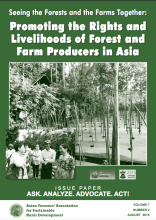Land Library
Welcome to the Land Portal Library. Explore our vast collection of open-access resources (over 74,000) including reports, journal articles, research papers, peer-reviewed publications, legal documents, videos and much more.
/ library resources
Showing items 1 through 9 of 18.There is a very close relationship between forestry and farming. Both forests and farms are source of food (both from plants and animals), nutrition, health, and livelihoods for family farmers. Besides, forests provide sources for fuel, energy, water and medicines.
As opposed to agribusiness or corporate farming, FAO defined family farming as “a means of organizing agricultural, forestry, fisheries, pastoral and aquaculture production which is managed and operated by a family, both female and male.
ELD is a joint initiative of Germany, the European Commission and the United Nations Convention to Combat Desertification (UNCCD). ELD offers a strong platform for raising public awareness of land degradation and advocating sustainable land-use strategies.
Soils around the world are degrading rapidly, reducing ecosystem diversity and some important functions, threatening food and other human securities, and increasing vulnerability to climate change. This is a vicious cycle created by and leading to further unsustainable land-use practices.
Soil carbon is important for soil structure and related nutrient and water holding properties. Increasing soil carbon stocks results in improved crop growth and contributes to enhanced climate resilience.
Farmers' Voices, Farmers' Choices: In the Time of Climate Change
In 2008, Ka Lita, a woman rice farmer in the Philippines, stood in a long line to buy rice that was being sold by the National Food Authority (NFA), the government’s rice trading agency.
Le Partenariat pour les Forêts du Bassin du Congo vise à concilier la protection des écosystèmes forestiers et leur utilisation pour le développement des pays d’Afrique centrale. Cet article présente ce qu’un «réseau stratégique» de ce type peut donner comme résultats, ainsi que ses limites.
Chaque année, 13 millions d’hectares de forêts sont perdus
dans le monde, ce qui représente la superficie globale de
l’Autriche et de la Suisse réunies. Cette déforestation touche
à raison de 90 pour cent des forêts tropicales. La perte de






